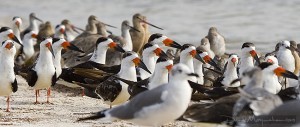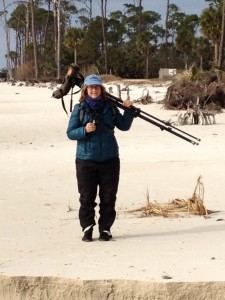Here is how the Christmas Bird Count found me on the third-to-last day of 2014: suspended between the divinity of the wild birds, and their utter vulnerability to human whims.
The territory that is ours to count in the annual Christmas census extends from the junction of 30A and Cape San Blas Road, and Stump Hole, on the St. Joe Peninsula. Our favorite stretch, and the most productive bird-wise, is the beach.
It used to be—just a year or two ago—that you could not drive a vehicle all the way to the tip of Cape San Blas (that ever, ever changing point of sand). You had to carry your fishing poles and your beach gear either from parking places at Stump Hole, or all the way from the houses near Money Bayou. Not too many people did, so wild birds thrived there, and you could usually find a great variety resting and re-arranging their feathers.
But the protective barriers are gone now. With a cheap permit from Gulf County, area residents can motor the whole length of that beach.
As a result, I was a distracted Christmas Bird counter this year. I should have been moving briskly, ticking off species and numbers of species, but I found myself obsessing about the impact of the cars and the people they ferry.
You’ve seen shorebirds standing around in groups on the beach, and maybe thought they were loafing without particular purpose. But between forays to fish, shorebirds need time undisturbed to rest, regroup, and dry, re-order and oil their feathers.
Jeff and I set up my spotting scope a good distance away from the hundreds of birds resting at the spit, and began to scan.
Royal tern, 110. Forster’s tern, 97. Caspian tern, 2, Sandwich tern, 2.
I named off the birds and numbers of each kind out loud, so Jeff could record them in a small, orange, waterproof notebook.
Black skimmer, 57. American oystercatcher, 3. Cormorant, 9. Brown pelican, 2.
A red Jeep came rolling down the sand, and several couples on foot moved towards us from the west.
“Jeff, quick, move between the birds and car tracks in the sand so the people will have to go around us,” I asked, and he did. I pressed the legs of my scope more firmly into the beach. It looked like a stiff, mutant spider, three-legged. As if in a football game, we body-blocked for the birds.
Willet, 4. Dunlin, 41. Western sandpiper, 10. Ruddy turnstone, 5.
Most people driving or even walking the beach will respect a human’s unspoken right to be where they will on the shore, and as I had guessed, these beach drivers circled around us to give us space.
Black-bellied plover, 1. Snowy plover, 7. Semi-palmated plover, 6. Piping plover, 3.
These same polite people don’t realize the non-negotiable needs and extreme vulnerability of shorebirds.
As the beach-goers drove away, my concern for the birds relaxed. They were no longer numbers, or species threatened by human activity. I was stopped by their magnificent beauty. A royal tern chick, bowing to and begging from its parent, for food. Northern breeding Bonaparte’s gulls, with white-trimmed wings and scrappy dispositions. A black skimmer, so tired it might have fallen face down in the sand, except for its massive bill, acting as a prop.
And the two of us humans, simply being, with the birds. To which tribe do I belong? My oh-so-human form and brain, or the at-risk wild birds? Or can I find a way to be a bridge between the two?
Share On:




Thanks for this message, Sue… from birds and bird-lovers alike. Most people just don’t know. (The 2nd photo – birds in flight – was a mixed flock on the Indian Pass beach, much as you describe. A 10 year old beach-walking boy was exhilarated to find he could create such a whirlwind of birds by simply running at the resting flock with his arms waving high. He did so again and again. Unleashed dogs go for the same thrill.
Thank you, Susan, for continuing to raise our awareness. Bless you and your work.
This has oftentimes been addressed statewide via county regulations. Since tourism and wildlife viewing is vital to this area, one would hope they would be amenable to barring motorized vehicles in sensitive areas. If not, they are jeopardizing an invaluable resource and income producer in reducing the volume of wildlife.
Another beautiful and thought-provoking post, Susan. Yes, you’re that bridge between the people and the birds. Most people care once they understand, and your words do so much to help us understand. Perhaps Gulf County will rethink those cheap permits.
I’ve been waiting to hear how the count went…I was with you out there!
Well thanks for asking, Martha! There were plenty of species 72 one day, 76 the next. But numbers of individuals are way down. I worry about the wild birds!